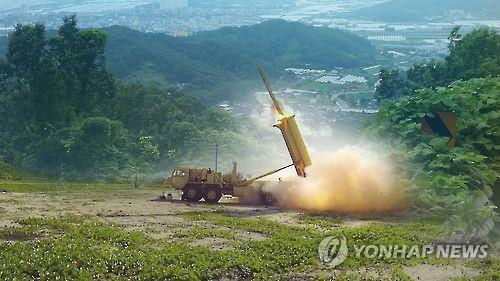South Korea and the United States will not share with Japan the information they obtain from the radar of an advanced anti-missile system that will be set up by late 2017, a government source said Monday.
Their remarks come amid speculations that the Terminal High Altitude Area Defense system to be deployed in South Korea is part of a wider move to integrate the South into the broader missile defense system operated by the U.S. and Japan.

"Under the trilateral information-sharing agreement with the U.S. and Japan, South Korea is obliged to share the information it gets on North Korea's nuclear and missile tests with Japan through the U.S. But the information detected by the THAAD radar won't be going to Tokyo," a government official familiar with the matter said.
Another official said it is "not effective" to share information on an incoming missile at its terminal phase of flight.
This, he said, will not help as an early warning system.
The THAAD battery to be deployed in Seongju, 296 kilometers south of Seoul, will be operated independently by U.S. forces in South Korea to protect U.S. military forces and its allied Korean forces, he added.
Meanwhile, it takes about 4 billion won ($3.5 million) a year for U.S. Forces Korea to operate a THAAD battery here, twice the 2 billion won needed annually for a Patriot PAC-2 system, according to government sources.
"There have been rumors that as it takes an astronomical amount of money to operate a THAAD system here, it will drive up the country's defense budget. But it does not demand a big budget," he said.
THAAD, a core part of America's multi-layered missile defense program, is designed to intercept incoming ballistic missiles at altitudes of 40 to 150 km after detecting the missiles with its component X-band land-based radar system.
A THAAD battery consists of six truck-mounted launchers, 48 interceptors (eight per launcher), a fire control and communications unit, and the AN/TPY-2 radar.
In the past two weeks since the July 8 decision by Seoul to allow a U.S. THAAD battery in the country, the South Korean government has tested the levels of electromagnetic waves emanating from the Patriot PAC-2 and Green Pine systems in Korea and a THAAD system in Guam to help allay health concerns among 45,000 Seongju residents.
The test results showed that radio waves from all of the three antimissile systems didn't pose health risks. But Seongju residents have not accepted the results, raising the possibility that radar waves in the Guam THAAD battery were not gauged when the system was in full-scale operation.
"The radar waves of THAAD are stronger than those of the PAC-2 system and weaker than those of the Green Pine system," Defense Ministry spokesman Moon Sang-gyun said in a briefing on Monday. "We will continue to make efforts to help Seongju residents understand the THAAD system won't pose any harm to their health and the crops they grow." (Yonhap)




![[Exclusive] Hyundai Mobis eyes closer ties with BYD](http://res.heraldm.com/phpwas/restmb_idxmake.php?idx=644&simg=/content/image/2024/11/25/20241125050044_0.jpg)
![[Herald Review] 'Gangnam B-Side' combines social realism with masterful suspense, performance](http://res.heraldm.com/phpwas/restmb_idxmake.php?idx=644&simg=/content/image/2024/11/25/20241125050072_0.jpg)

